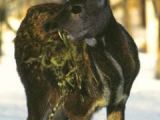Do you use Givenchy, Hugo Boss, Kelvin Klein products?
If you enjoy the musky odor, you should also know where it comes from.
Or at least from where it used to come in other times.
Musk is one of the most penetrating and persistent chemical compounds, which distinctly expels scent in millions of cubic feet of air without any visible weight loss.
There's almost no perfume that lacks musk, as it gives power and endurance odor to vegetable flavors, like floral, tobacco or woody.
The active principle of the musk is muscone, an oily liquid, but the musk also contains ammonia and fatty matters. Because of the ammonia, concentrated musk has a stinky odor, but once diluted, you will feel the pleasant strong musk scent.
Muscone is very slightly soluble in water but miscible with alcohol (that's why many perfumes contain alcohol).
But which is the source of musk?
Musk is secreted by a gland in the abdomen of the male musk deer.
Musk deer are somehow related to true deer, but are much smaller, 7-17 kg (18-43 pounds), do not have antlers and possess huge tusks (see the skull).
The male deer produce musk which acts as sexual pheromone during the courtship (hence, maybe, the human fascination for the musk).
The word musk comes through Persian and Latin from Old Sanskrit "mushkas" ("testes").
Only this musk is exploited in perfumery for thousand of years (in 3500 BC was used in China), but there are also other animals secreting musk, like the muskrat, an aquatic rodent from North America introduced to Europe, the Musk Duck (Biziura lobata) of southern Australia, musk shrews (Crocidura), the musk beetle (Calichroma moschata), the American alligator, the musk ox and other animals.
There are also plants secreting musk, like musk flower (Mimulus moschatus), the musk wood of the Guyana and Antilles, and in the seeds of Abelmoschus moschatus (musk seeds).
Despite this variety, only the musk of the deer has a commercial value.
At least in vertebrates, musk is secreted only by males and functions as a sexual pheromone, while in insects and plants could be a repellent for their consumers.
To get the perfume, the animal is usually killed and the gland completely removed and dried, either in the sunlight, on a hot stone, or by immersion in hot oil.
Whole glands are sold as "musk in pod" (photo above and bellow) while the perfume is extracted as "musk in grain".
There are 7 musk deer species, all in Asia, but only two are widely spread and more exploited: the Himalayan and Siberian (in Eastern Siberia).
That's why the quality of the musk varies.
Tong-king, Chinese or Tibetan, imported from China is the most expensive; from Assam or Nepal is less valuable and Karbardin, imported from Central Asia by way of Russia, the least valuable and hardly admitting adulteration.
The Tong-king musk is exported in small, flashy decorated caddies with tin or lead linings, wherein the perfume is sealed down; it is now usually transmitted directly by parcel post to the merchant.
Good musk has a pungent odor, dark purplish color, dry, smooth and is waxy, unctuous to the touch, and bitter to the taste. It is soluble in boiling water to the extent of about one-half; in alcohol up one-third and ether and chloroform dissolve still less.
This musk has been highly valued as a base for perfumes, soaps, and medicinal products.
Because of its varied uses, special properties, and rareness, the musk is reputed to be the most expensive animal product available, valued at up to $45,000 (USD) per kilogram. And one gland contains about 28 g of musk.
The gland can be removed without killing the deer, but this is seldom done.
Moreover, the animal is usually trapped in snares, which means that many females and offspring, which do not possess musk glands, are killed uselessly, not to mention that poaching is rampant where the deer live.
That's why all musk deer species are threatened and almost all muscone used in perfumery today is synthetic.
In 1888 artificial muscone, with a similar odor to natural musk, was obtained by condensing toluene with isobutyl bromide in the presence of aluminum chloride and nitrating the product.
Since then, many types of synthetic muscone have been achieved and the variety in odor seems to be conferred by the symmetry of the three nitro groups.
Farming operations are being now conducted in China to reduce the pressure on wild populations, and in the past experiments were done in former USSR.

 14 DAY TRIAL //
14 DAY TRIAL // 


